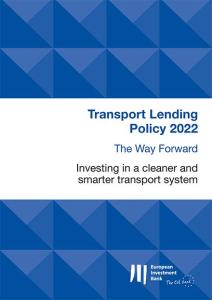Our Transport Lending Policy applies to all EIB financing in the transport sector, and it is designed to ensure that the Bank’s activities in the transport sector are consistent with and support EU policies. The new Transport Lending Policy is aligned with the Climate Bank Roadmap framework, which will be reviewed in 2023.
The Climate Bank Roadmap determines if projects in the transport sector, as well as other sectors, are eligible for EIB support. It sets out guiding principles and criteria to reinforce the Bank’s contribution to its sectors of activity and takes climate change and environmental concerns into account.
The challenges facing the transport sector include:
- Climate and environmental impact
- Safety and security
- Connectivity, equal accessibility and development
- Digitalisation and automation
- Sustainability of cities
- Funding and financing
Background
The transport sector has traditionally been among the main recipients of EIB support. There are many barriers to investment in transport infrastructure, vehicles and vessels. We support transport through loans, equity, guarantees and advisory.
A sustainable transport system is:
- Safe and secure
- Accessible to all
- Green
- Efficient
The EIB Transport Lending Policy
The Transport Lending Policy defines priorities within the eligibilities set in the Climate Bank Roadmap. Setting priorities is critical, as the need for investments in clean transport vehicles and supporting infrastructure is vast. The Transport Lending Policy identifies the types of investments that matter the most to transform our transport system.

Highlights
Transport infrastructure must become climate resilient, adapt to the needs of clean vehicles and expand to meet future demand. This will require significant new investment.
Current modes of transport, which depend on fossil fuels, need to be rapidly replaced by clean vehicles and vessels. Infrastructure to support greener transportation will also be necessary.
The priorities for the EIB’s support to the transport sector are:
The EIB will prioritise collective transport as it is key to making urban mobility safe, affordable, green and efficient. To complement collective transport, the Bank will also prioritise active and shared mobility schemes, like walking and cycling. Support to the digitalisation of transport systems as well as to clean vehicles, such as e-buses, taxis and automated shuttles, are also among the EIB’s priorities in urban mobility.
Investments in intermodal and logistics hubs will also be a priority, including in the context of urban regeneration and reorganisation increasing proximity and transport efficiency, combining IT and logistic platforms to improve the efficiency of urban freight and reduce its environmental impacts.
The EIB will prioritise support to electrified rail infrastructure as well as to electrified and other clean rolling stock. Infrastructure investments in digitalisation and automation will also be a priority, as a means of optimising the use of rail resources and capacities and improving safety and interoperability, as well improving the integration and connectivity between the different modes in the transport system. Finally, the EIB will develop innovative financing facilities enabling modernisation, retrofitting, digitalisation and automation of railway rolling stock, train and locomotive fleets, which are all priorities for EIB support.
The EIB will prioritise support to investments in strategic networks, notably TEN-T, road safety, the deployment of net-zero vehicles, investments in Intelligent Transport Systems and digital solutions, as well as road infrastructure upgrade and rehabilitation.
The EIB’s priorities in supporting inland waterways transport include infrastructure upgrade and rehabilitation, digitalisation of waterways and vessels, as well as renewal and cleaning of existing fleets.
The EIB will prioritise support to the development of strategic port infrastructure, as well as the digitalisation and decarbonisation of ports. As regards maritime vessels, the EIB will prioritise the development and deployment of zero direct CO2 emission ships via pilot and demonstration projects.
As per the CBR, the Bank will refrain from supporting any increases in airport capacity or conventionally-fuelled aircraft. The Bank will prioritise investments in the decarbonisation and operational resilience investments in TEN-T airports; the development and deployment roll-out of zero direct CO2 emission aircraft via pilot and demonstration projects; as well as investments that will increase the digitalisation of the sector.
Who contributed?
The EIB’s direct mailings reached over 3 500 individuals and organisations.
The EIB held bilateral meetings with institutional partners such as other European institutions and UN agencies.
Public consultation
The Transport Lending Policy was adopted in July 2022 by the Board of Directors. The EIB Group conducted a public consultation on its Transport Lending Policy from July to October 2021.
The review of the Transport Lending Policy was an open and inclusive process, involving industry, institutions, civil society and the public at large.
The Bank will review this lending policy in 2025.



